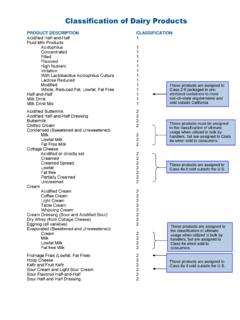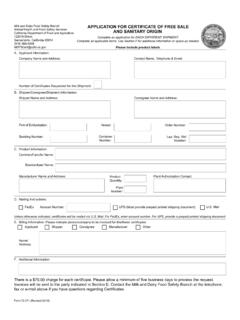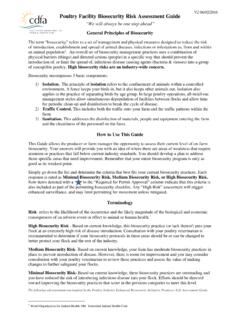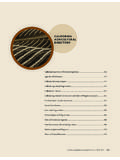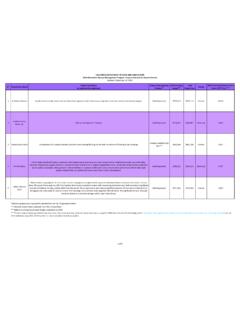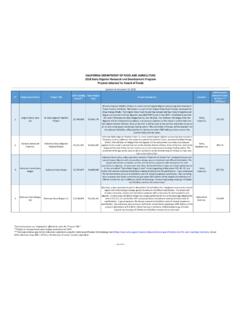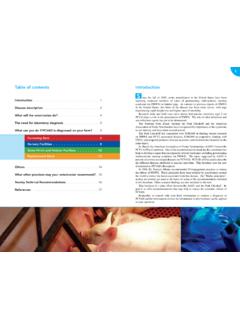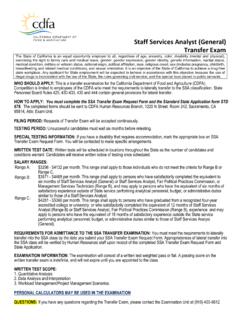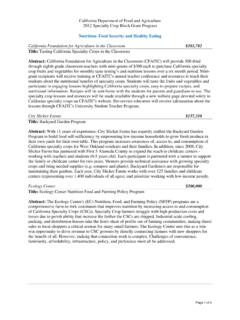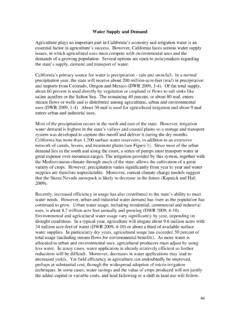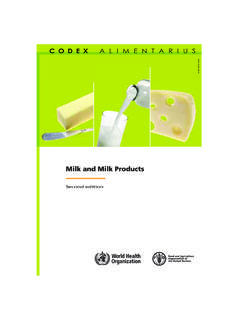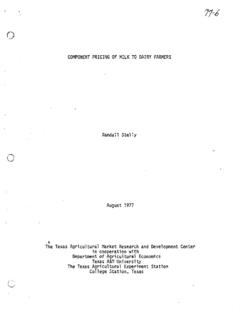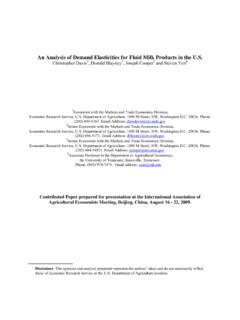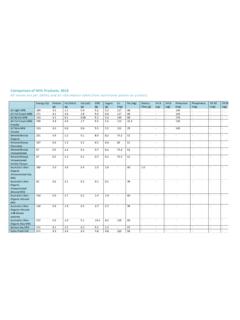Transcription of California Milk & Dairy Product Marketing Provisions
1 ModocLassenShastaTrinityHumboldtMendocin oTehamaButtePlumasGlennLakeSierraColusaY oloSonomaYubaNevadaPlacerEl DoradoSutterNapaSolanoSacramentoAmadorAl pineMonoMarinContra CostaSanJoaquinCalaverasSan MateoAlamedaTuolumneSanta CruzSanta ClaraStanislausMercedMariposaMaderaSanBe nitoMontereyFresnoKingsInyoTulareSan Luis ObispoKernSanta BarbaraVenturaDel NorteSiskiyouModocLassenShastaTrinityHum boldtMendocinoTehamaButtePlumasGlennLake SierraColusaYoloSonomaYubaNevadaPlacerEl DoradoSutterNapaSolanoSacramentoAmadorAl pineMonoSan FranciscoMarinContra CostaSanJoaquinCalaverasSan MateoAlamedaTuolumneSanta CruzSanta ClaraStanislausMercedMariposaMaderaSanBe nitoMontereyFresnoKingsInyoTulareSan Luis ObispoKernSanta BarbaraLos AngelesOrangeSan Diego Imperial Riverside San BernardinoVenturaNorthern California MilkMarketing AreaSouthern California MilkMarketing AreaCalifornia Department of Food and Agriculture1220 N Street Sacramento, CA 95814 Phone (916) 900-5014 / Fax (916) 900-5341 Website milk & Dairy Product Marketing ProvisionsUpdated June 2014 California milk & Dairy Products Marketing Provisions Table of Contents Page Introduction.
2 1 Determining Cost .. 2 Promotions .. 5 Meeting Competition .. 7 Allowances and Special Accounts .. 8 Food and Agricultural Code, Sections 61381-61391, 61441-61443, 61571-61573 .. 10 California Code of Regulations, Chapter 3, Subchapter 1 .. 13 Appendix Glossary of Terms/Definitions .. 15 Price Schedules, Hypothetical Schedules/Example .. 18 Price Discrimination .. 29 Public Agency Prices .. 34 Solicitation, False Statements, Legal Actions, 36 California Department of Food & Agriculture Dairy Marketing Branch 1220 N Street Sacramento, CA 95814 (916) 900-5014 Fax (916) 900-5341 Email Address: Website: 1 Introduction The California Department of Food and Agriculture (Department) promotes the intelligent production and orderly Marketing and distribution of all milk and Dairy products to ensure availability to consumers of an adequate and continuous supply of pure, fresh, wholesome market milk .
3 The Department s Dairy Marketing Branch (Branch) is responsible for enforcing the Provisions of the California Food and Agricultural Code (FAC) and related regulations concerning the Marketing of milk and Dairy products. Branch staff performs investigations to verify compliance with Dairy industry laws and may exercise its authority to take enforcement actions. The FAC, administrative regulations, Pooling Plan, and Stabilization and Marketing Plan Provisions apply equally to all manufacturers, distributors, producers, wholesale customers, brokers, or any representative of them. These Provisions were adopted to maintain an orderly and stable market for milk and Dairy products by discouraging Marketing tactics that may cause sudden market price fluctuations. The laws also deter the formation of monopolies in the wholesale and retail sectors of the Dairy industry, which if left unmonitored, could lead to discriminatory practices and predatory pricing designed to force competitors out of business.
4 The basis of the milk and Dairy products Marketing Provisions discussed in this booklet is found in the FAC, Division 21, Part 3, Chapter 1, Sections 61381 through 61391 (website: ). A copy of these laws is included at the back of this booklet. The regulations related to these Provisions of the FAC are contained in Title 3, Chapter 3, Subchapter 1 of the California Code of Regulations (CCR) (website: ). A copy of these regulations is included at the back of this booklet. Classification of Dairy Products A list of Dairy products and the class into which they are categorized can be found on the Branch website at: Record Keeping/Departmental Access/Confidentiality Any distributor, manufacturer or person who sells at wholesale is required to maintain and keep certain records.
5 In addition to price schedules and terms and conditions, records must be kept of all milk received, processed and sold, the quantity sold, the price received and all costs of handling, processing, sale and delivery, FAC Section 61441. The Secretary, or his/her representatives, shall have access anywhere records concerning milk and Dairy products are kept, which includes any place where Dairy products are sold. The records may be inspected and copied at any place in the State, FAC Section 61442. Information obtained pursuant to these Provisions is confidential and shall not be divulged, except if necessary for the determination of any court proceeding or hearing before the Secretary or his/her representatives, FAC Section 61443. 2 Determining Cost FAC Section 61384 states that the sale below cost by any retailer, wholesale customer, manufacturer, or distributor, including any producer-distributor or nonprofit cooperative association acting as a distributor, of milk , cream, or any Dairy Product at less than cost is an unlawful practice.
6 This section also defines the meaning of cost as applied to each of the types of Dairy entities. Cost is further defined in CCR Sections 1811, 1812, and 1850. Section 1811 specifies cost components of Dairy processing for manufacturers, distributors, and handlers. Section 1812 specifies cost components of retailers and wholesale customers. Section 1850 specifies cost components for promotions. Processors Those who process Dairy products, (manufacturers) as well as those who buy finished products for resale (wholesale customers and retailers) are prohibited from selling Dairy products below cost, per FAC Section 61384. When determining compliance with sales below cost Provisions , the costs associated with processing differ from those associated with wholesaling. Manufacturer costs include raw Product , manufacturing, processing, handling, sale, and delivery.
7 CCR Section 1811 details specific cost components which must be included in cost calculations for manufacturing. Promotional discounts, advertising allowances, redemption devices, rebates, etc., are types of costs that must be factored in, if applicable. Wholesale Customers (Retailers and Non-Processing Distributors) Cost, as applied to wholesale customers, means the invoice or replacement cost, whichever is lower, plus the cost of doing business of the wholesale customer. The Branch calculates the cost of doing business by determining total sales income and all operating expenses. This information is provided by the wholesaler, most often derived directly from the wholesaler s most recent tax filing. Total operating expense is divided by the total sales income, generating a percentage that represents the wholesale customer s cost of doing business.
8 For example, HEY Market's profit and loss statement for the period of January 1, 2012 to December 31, 2012, indicates total sales income of $1,000,000 and total operating expenses of $150, total operating expenses of $150,000 divided by the total sales income of $1,000,000 equals the cost of doing business of HEY Market, which is 15 percent. HEY Market's invoice cost for a gallon of homogenized milk is $ To arrive at this market's minimum lawful retail price, the grand markup method is used. The grand markup method applies the cost of doing business on the invoice price. The following calculation illustrates this method: INVOICE PRICE 100% MINUS COST OF DOING BUSINESS = MINIMUM LAWFUL RETAIL PRICE $ = $ = $ MINIMUM LAWFUL RETAIL PRICE ( ).
9 85 HEY Market's $ cost for a gallon of homogenized milk divided by 100 percent, less HEY Market's 15 percent cost of doing business equates to $ divided by .85 which equals $ This is HEY Market's minimum lawful retail price. 3 Scan-Based Trading (SBT) and Direct Store Delivery (DSD) Scan-Based Trading (SBT) and Direct Service or Store Delivery (DSD) are offered by some Dairy vendors to their retail customers. With SBT, the vendor maintains title to the Dairy Product until it is scanned through checkout at a retail establishment. At that time, it becomes the property of the retailer. With DSD, the vendor s staff stocks and rotates Product at the retail establishment. Both of these methods of distribution reduce operating expenses of the retailer.
10 The Branch allows retailers buying Dairy products from such vendors the option of taking a 5 percent deduction off their normal cost of doing business percentage. Generally the use of the DSD method reduces the cost of doing business by 5 percent. Use of the SBT method reduces the cost of doing business by 4 percent. Use of both methods by a retailer reduces the cost of doing business by a total of 9 percent. Retail stores using one or both of these methods have the option of reducing their cost of doing business by 5, 4, or 9 percent, maximum. For ice cream and frozen snacks only, a retailer may reduce his cost of doing business markup to percent for DSD, and an additional percent is allowed if also using SBT, for a total cost of doing business markup of percent when both methods are used by a Dairy vendor.
